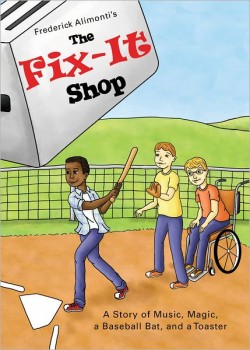Author Showcase
By Bianca Schulze, The Children’s Book Review
Published: October 22, 2011
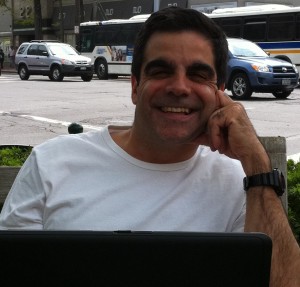
Frederick (Rick) Alimonti is a lawyer living in Armonk, New York. The Fix-It Shop is his third published work. Rick is married with three children and his been writing since College, where he was active in various literary magazines. Rick’s other publications address such issues as “stranger danger” and the value of diversity.
TCBR: Can you share a little on your background and how you became a children’s book writer?
Frederick Alimonti: Sure. I was born in 1963 and raised in Flushing, Queens, New York. I am the youngest of three; I have two older sisters. I spent many summers as a teenager working in upstate New York. My writing is definitely a product of both urban and rural environments, and I draw liberally from both.
Now, I live in Westchester, New York with my wife Ann and our three children, Simone, Celeste, and Lucas. Lucky Lucas! Now it’s his turn to grow up with two older sisters!
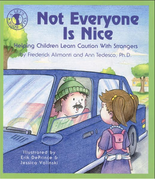 As to my writing, I have always enjoyed writing, and I have several adult projects both completed and underway in addition to children’s works. I began writing for my own children, and practically stumbled upon a market for my first book, Not Everyone is Nice: Teaching Children Caution with Strangers. All of a sudden I was a published author with an agent!
As to my writing, I have always enjoyed writing, and I have several adult projects both completed and underway in addition to children’s works. I began writing for my own children, and practically stumbled upon a market for my first book, Not Everyone is Nice: Teaching Children Caution with Strangers. All of a sudden I was a published author with an agent!
I came to really enjoy writing for children; and I have wonderful childhood memories of my own from which to draw. I studied other authors and read up on writing for children. The more I wrote for children, the more I came to love it. Children are so flexible and free-thinking. They are open to new thoughts and ideas. And they find lessons and meanings in my stories that I never even knew were there.
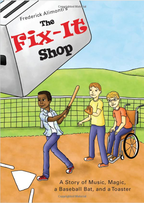 The Fix-It Shop: A Story of Music, Magic, a Baseball Bat, and a Toaster weaves relatable characters and an element of fantasy, with modern life lessons.
The Fix-It Shop: A Story of Music, Magic, a Baseball Bat, and a Toaster weaves relatable characters and an element of fantasy, with modern life lessons.
What would you say is the most important lesson that readers will take away from reading your book?
I would have to pick two lessons. The first is a lesson of self-value and self-appreciation. In our story, Tommy thinks his cerebral palsy makes him less than perfect. He comes to learn otherwise in a very dramatic and unique way. I hope readers will see the perfection in all of the flawed people around them, and themselves as well.
The second lesson is to open our minds to the wonder around us. Our other main character is Ed Lunden. There is definitely something special about him. But his “magic” is really up to the reader to decide, and there is no right or wrong conclusion. I personally like the message in the book that sometimes there is really no need to explain things but rather to just accept them as wonderful.
What age group did you write the book for?
The children’s age group is 9-13, but I hope there is something in this book to make an adult smile too.
What can you tell us about the lead character, Tommy, who has cerebral palsy?
Tommy is a great kid. He could be any kid, anywhere. In creating Tommy, I really wanted his palsy to be incidental to who he is although it is nonetheless very central to our story. I think I only mention palsy once by name. As we learn about Tommy, we come to learn that his palsy and wheelchair by no means come even close to defining who he is. His friends, especially Billy, seem to know this all along, but Tommy needs to learn this for himself. If I did my job right, with a little help from Ed and the Fix-It Shop, Tommy finds out just how special and indeed how “perfect” he has been all along.
Would I be correct in saying that your goal is to promote discussions amongst readers about people and the world around them? If so, what have you found to be the main theme for discussion?
The main them for discussion is often how the characters do, or do not, evolve in the course of the story. I think that it is very important for characters to learn, make mistakes, and evolve. In our story, Tommy has the most to learn; Billy, who is something of a cynic, has his eyes opened a bit. Indeed, all of the townspeople who pass through the Fix-It Shop are somehow altered and gain new perspectives of some kind. Our child readers deserve better than unyielding, unchanging “stock characters.”
Do children typically begin the discussions or are parents facilitating the discussions by using elements from your story as ‘teachable moments?’
It depends upon the child and the situation. It has been my experience that children tend to get really excited about meeting an author and love to ask questions about the story. It is probably a bit more challenging for a parent or teacher, but I think a few questions to the children can quickly get things going. I like to use story dialogue to provide “teachable moments.” I think that Ed Lunden’s explanation to Tommy as to how being perfect has very little to do with being flawless is a good launch point for the discussion.
The Fix-It Shop is your third published book. Can you tell us a little about your first two books, Not Everyone is Nice and Tommy and the T-Tops?
Sure! Not Everyone is Nice is a picture book on “stranger danger.” It involves a kindergarten student that has an encounter with a stranger who tries to lure her into his car. Her mom intervenes, and her parents later teach her about strangers using examples from nature that show how you cannot tell if something is safe just by how it looks and acts. It is told in the first person from the child’s perspective. I tried to write a story that could facilitate a parent-child dialogue on this challenging topic but not be too scary either. I think I achieved the right balance.
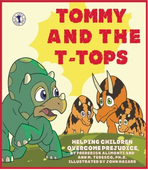 Tommy and the T-Tops is a bit more complex, although also a picture book. It deals with prejudice as told through a herd of green triceratops that first rejects a family of refugee striped triceratops. Later, and only after some major drama, does the green herd comes to adopt the striped family. The book touches on such topics as war, famine, prejudice, leadership, and wisdom. It ultimately asks questions about what makes us different, what is the value of diversity, and what are our responsibilities to our fellow beings as inhabitants of the same planet?
Tommy and the T-Tops is a bit more complex, although also a picture book. It deals with prejudice as told through a herd of green triceratops that first rejects a family of refugee striped triceratops. Later, and only after some major drama, does the green herd comes to adopt the striped family. The book touches on such topics as war, famine, prejudice, leadership, and wisdom. It ultimately asks questions about what makes us different, what is the value of diversity, and what are our responsibilities to our fellow beings as inhabitants of the same planet?
Should we expect to see another book from you soon?
Yes. I just signed a contract for Inside Out, a poem story involving a very popular middle school girl who awakens one morning to find that her appearance now reflects her character. She comes to learn a great deal about true beauty by the time the “School of Inside Out” is done with her. I am really excited about this new work and can’t seem to stop tinkering with it.
What would you say has been the most personally rewarding aspect of becoming a children’s book author?
It is very satisfying when something you have written really resonates and touches something within a child. Kids have this wonderful and contagious enthusiasm, and it’s inspirational when I get to observe it. My own children think it is really “cool” that I am a published author, and that’s pretty satisfying too. After all this parent/child need for approval is a two-way street, right?
Absolutely!
Do you have anything specific that you want to say to your readers?
Just that I hope you will read, enjoy, and talk about my books. Reviews on Amazon and Barnes & Noble sites are also most welcome.
The Author Showcase is a place for authors and illustrators to gain visibility for their works. Learn more …

